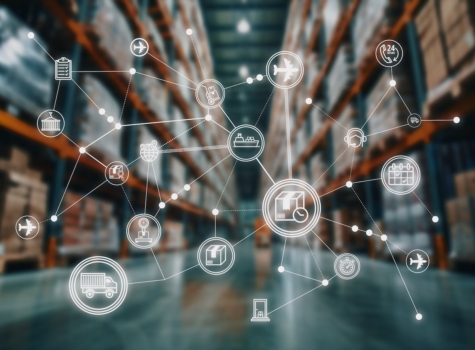Every business’s fulfillment operations look a little different.
Small ecommerce brands might still be storing inventory and packing boxes in a garage or home office. On the other end of the spectrum, larger businesses usually run complex warehouses, complete with hundreds of employees and well-defined processes.
But regardless of size, organizations shipping packages to consumers have one thing in common: logistics automation is key to staying competitive and increasing customer satisfaction.
What is logistics automation?
Logistics automation involves using technology, including both software and machinery, to perform logistics and supply chain tasks.
Replacing manual labor with automated solutions increases efficiency and accuracy, cuts costs, improves safety, and opens the door to accelerated business growth.
Logistics automation is often used to optimize the following tasks:
- Demand forecasting. Businesses often use AI-powered analytics platforms to predict sales spikes based on historical order data, seasonality, and external factors like weather. Machine learning models can also forecast demand at the SKU level, helping businesses avoid overstocking or stockouts.
- Procurement. Many companies use automated sourcing platforms that match purchase orders to preferred suppliers based on price, lead time, and availability. Some systems even trigger restock orders automatically when inventory drops below a set threshold.
- Inventory management. Technology like RFID tags and IoT sensors helps with inventory management, giving businesses real-time visibility into stock levels without manual counts. Cloud-based inventory software can automatically sync data across multiple warehouses and sales channels.
- Warehouse management. Automated guided vehicles (AGVs) and autonomous mobile robots (AMRs) move pallets and bins across warehouses without human drivers, while AI-powered warehouse management systems (WMSs) plan picking routes that reduce travel time.
- Order fulfillment. In high-tech warehouses, the order fulfillment process might involve robotic picking arms that quickly retrieve items for packing. And regardless of a business’s size, automated shipping software always comes in handy for carrier selection and label generation.
- Returns management. Automated portals allow customers to generate return labels and track refunds without calling support. For an even more streamlined process, many companies use AI tools that route returned items for restocking, refurbishment, or disposal.
- Customer support. Even customer support can be automated! Although it’s a good idea to have humans available to help with complex problems, AI chatbots can answer common order and shipping questions instantly.
How logistics automation transforms business
Logistics automation transforms every aspect of a business, from day-to-day operations to the safety and well-being of employees. Let’s take a look at what that might look like:
Operations
Automation shifts day-to-day logistics tasks from manual processes to technology-driven workflows.
Example: Instead of employees keying in order data by hand or moving pallets across the warehouse, automated software and robotics handle the bulk of the work. This not only helps companies avoid the disruptions caused by labor shortages but also makes it easier to scale during high-demand periods.
“Automation in warehousing is no longer just nice to have but an imperative for sustainable growth.” — McKinsey
Workforce
Even the most automated operations still rely on people. What’s changing is the type of work—rather than repetitive physical labor, logistics teams need people with technical knowledge to monitor systems, manage exceptions, and keep automated equipment running smoothly.
Example: Amazon recently deployed its one millionth warehouse robot, but it continues to employ thousands of human workers.
Supply chain resilience
Disruptions are unavoidable in supply chain management. But with automated systems in place, businesses can respond quickly to unexpected issues and build resilience.
Example: AI forecasting tools can quickly reroute inventory when a regional warehouse is at risk of running out. The same goes for order routing; during a peak season surge, an automated system might shift volume to a less busy fulfillment center to avoid bottlenecks.
Decision-making
Automation replaces guesswork with hard data.
Example: Real-time dashboards and AI analytics let managers see actual shipping performance, costs, and inventory levels, then make fast, data-driven decisions about everything from carrier selection to warehouse staffing.
Sustainability
Automation makes logistics greener by reducing waste and using resources more efficiently.
Example: Automated packing systems right-size boxes to minimize excess packaging, while route optimization software cuts fuel consumption by planning the shortest and most efficient delivery paths.
Why automate your logistics?
The transformations in the previous section might sound great … but they might also sound expensive. AI dashboards, automated packing systems, and picking robots—these tools don’t come cheap.
But when you’re careful about implementing the right logistics automation systems at the right time, making the investment always pays off. In as little as a few weeks, you’ll start to see increased efficiency, lower costs, better visibility, and other benefits.
Increased efficiency and accuracy
With automation, your logistics teams will move faster and make fewer mistakes. Repetitive tasks like order processing, inventory counts, and warehouse operations can all be handled by machines that don’t get tired or distracted, meaning more work gets done in less time.
By optimizing how space, time, and materials are used, you can reduce wasted effort and make your operations far more precise.
Lower costs
Costs are on the minds of logistics leaders. In one recent survey, almost 75% of executives reported that per-package delivery costs have increased over the past year, and most said that cutting last-mile delivery costs was a priority.
If you’re in that boat, automation is the way to go. With more efficient warehouse management and order fulfillment, you’ll keep per-order costs low. Additionally, reducing labor needs and mistakes helps cut both payroll and costly shipping errors.
“The biggest bang for your buck is going to be automating your shipping process. … Your shipping costs are going to eat almost all of your other costs bar none, so you’re going to get a much bigger return on your time and technology investment.” — Kevin Gaul, RF-SMART
Enhanced visibility
One of the biggest challenges in logistics is not knowing exactly where inventory or orders stand. Automation solves this by providing real-time data at every step, giving you full visibility into stock levels, shipping statuses, and warehouse performance.
Greater customer satisfaction (and loyalty!)
Customers expect fast shipping—3.5 days is the longest many people are willing to wait—and automation makes it possible to deliver.
Faster order processing ensures products get out the door quickly, and better accuracy means customers receive the right items on time. Meeting these expectations consistently builds trust and loyalty, encouraging repeat business.
Improved safety
Workplace injuries and accidents can have a big impact on your bottom line. Automation helps by reducing the risks associated with warehouse work, allowing machines to take on strenuous or dangerous tasks.
Maximize efficiency with logistics automation software
When it comes to logistics automation, success depends on using the right tools.
To speed up picking, you need a reliable WMS to get started and warehouse robotics to take things to the next level. To streamline returns management, you need a platform that automatically screens for fraud and processes returns.
And to increase the efficiency of your parcel shipping, you need a smart system like Luma by EasyPost. Trained on data from billions of shipments, Luma tracks carrier performance, finds the best labels for each package, and identifies cost- and time-saving opportunities so your team doesn’t have to.
- Luma Insights provides visibility and peer-shipper benchmarking to help you understand the current state of your shipping.
- Luma Advisor gives AI-powered recommendations to help you cut costs and improve on-time delivery rates.
- Luma Select automatically purchases labels according to your custom business rules and Luma Advisor’s suggestions.
Automate your shipping with Luma
Put parcel shipping on autopilot, get the best deals, and make sure every package arrives on time.



